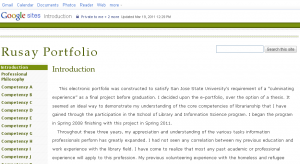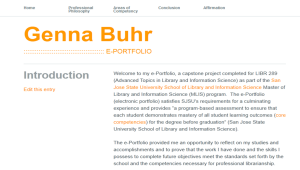Published on
Using an Electronic Portfolio as a Capstone Project: The Rationale, Logistics and Reflections (Part 3)

In the first part of this series, we explained the context and purpose of the e-Portfolio as an authentic assessment for the Master of Library and Information Science program at San Jose State University. Last week, we described how to create e-Portfolios using two learning management systems, ANGEL and D2L, complete with examples from student work. In this part of the series, we will show two examples of students’ e-Portfolios created on two freely-available web platforms, Google Sites and WordPress.
e-Portfolio as a Website
If students elect not to use D2L to display their e-Portfolios, they often use Google Sites, Weebly, WordPress or a similar tool; alternatively, they can hand-code their site. If students choose to use a interface not supported by the School of Library and Information Science (SLIS) for their e-Portfolio, they need to have their selection approved by their advisor. Generally, an advisor applies the following criteria in deciding whether a student’s chosen platform is acceptable:
- Navigation
- Can the user easily move from one part of the e-Portfolio to the next?
- Is the navigation intuitive and clear?
- Functionality
- Does the interface allow for a range of file formats to be attached and/or integrated
- Security
- Is the site password protected? (SLIS requires that the e-Portfolio be password protected.)
- Can the contents of the e-Portfolio be found through a search engine? (SLIS does not allow for e-Portfolio contents to be indexed by search engines.)
If the advisor deems the interface acceptable based on these criteria, the student is allowed to use the selected interface.
Sylvie Rusay and Genna Buhr both selected an alternate interface for their e-Portfolios. As is evident in Figure 3.1, Sylvie used the freely available Google Sites, and she restricted access by making the site private and only accessible to her e-Portfolio advisor through the Google permissions features. Thus, she did not need to password protect her site. Her navigation bar, with links to each competency essay, the introduction, professional philosophy and conclusion is along the left margin, similar to the organization in D2L. As can be seen in Figure 3.2, Genna used WordPress to present her e-Portfolio. She created a password to protect the e-Portfolio by using WordPress features, giving access only to her e-Portfolio advisor. She created her navigation along the horizontal bar at the top of the page, with each of the competencies as links coming from the drop-down menu under the link labeled “Areas of Competency.”


Advantages of a website
Students who want more control over the design of their e-Portfolio, and continued access to it after graduation, are likely best served by selecting an interface that is not supported by SLIS. For some students, being able to create their own site is a skill they want to cultivate, and so they forego the potential for technical support to work independently.
Disadvantages of a website
The main disadvantage of creating an e-Portfolio as a website is that we in SLIS do not provide technical support. Thus, students need to be quite independent if they choose this route. They need to have not only the know-how, but also the time to devote, to designing a website, even though they will be graded on its content, not its design. Additionally, students must secure a server on which to host their site, and this, of course, can cost money.
Author Perspective: Educator



